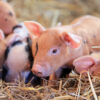
by Caroline Fairs
A Little Dose of Nature
Growing up in the ‘90s and early 2000s, I have many happy memories of spending long afternoons playing outside with the other young children on my street. Day after day after day of the long summer holidays was spent playing endless games of hide-and-seek, going on ‘wild’ adventures through the overgrown scrub and meandering alleyways at the back of our houses, foraging for leaves, twigs and tiny creatures with which we could concoct potions or make mini imaginary worlds. Hours would melt away. Time itself ceased to exist until we were brought back to sharp reality by the nag from our mums to “please come in, tea’s on the table” to which we would plead “just five more minutes”, so desperate we were to stay in our nature-filled, make-believe world. Days like these were pure magic.
I’ll always be grateful that I grew up just before the advent of smartphones and social media. Life seemed simpler back then. In just a couple of decades, our lives and especially those of our children have drastically changed – everything seems busier, more stressful and with more pressure than ever to be doing, achieving, progressing – whatever happened to slowing down, finding joy in simplicity and noticing things? Despite the fact we have more ways of distracting and entertaining ourselves than ever before, our children seem unhappier than ever. The results of the most recent surveys show that 1 in 7 five to ten year olds suffer with a mental health problem, an increase from 1 in 10 in 2017.
There seems to be an epidemic of poor mental health affecting our children and while there are many factors that are contributing to this, our increasingly sedentary, indoor lifestyles are clearly playing a role, with some going as far as saying that we are raising a generation of children suffering from ‘nature-deficit disorder’.
The American biologist, Edward Wilson set out his popular biophilia theory in 1984 in which he argued that as humans we are intrinsically drawn towards our natural surroundings with a desire to interact with other life forms. In other words, we are meant to be outside in nature – that’s where we thrive. As a mum of a young daughter, I’ve witnessed the seemingly magnetic pull of nature first-hand – she loves nothing more than playing outside, bounding from one muddy puddle to the next on our walks, giggling as she rolls down hills and collecting nature’s ‘artefacts’ with a look of such curiosity on her face, it makes my heart soar. This is where she’s happiest. And these are all simple things – no complicated toys or gadgets, just things that you can find right outside your door for free: nature’s gifts. Granted, my daughter is young enough still to be persuaded to turn off the TV but even older children, forever on their smartphones, still have it within them to find joy in nature – that innate pull to the natural world is still there, we just need to set it free.
So why is nature so good for our children? We can already see for ourselves that being outside in nature has an overwhelmingly positive effect but in her book, ‘A Little Dose of Nature’, psychologist Dr Alison Greenwood explains the benefits of nature’s five active ingredients: fractals (naturally occurring, repeating patterns), nature sounds, phytoncides (natural chemicals released by trees and plants), soil bacteria and sunlight. These intrinsic parts of nature not only help children feel happier and calmer, they can also improve focus, attention and sleep and boost their immune systems and even brain power! Engaging with the natural world can also improve confidence and inspire creativity and imagination as they explore new environments and find new ways of interacting with the world around them. Many studies have also shown that spending time outside can also help reduce ADHD symptoms. This is because being in natural green spaces engages children in such a way that requires little mental effort – many natural environments are highly fascinating to children and whet their inherent curiosity without them needing to think too hard. It is this fascination which has a restorative and calming effect.
There are many activities which you and your children can enjoy together in nature. Get them to use all five of their senses on a walk – can they spot any fractal patterns – clouds or leaf veins? Can they hear any nature sounds such as birds singing? Are their any flowers or plants they can smell? What can they touch – the rough bark on a tree or soft grass? Taste is a little trickier but maybe if you’re lucky you might come across some blackberries or even some wild garlic!
How about planning a forage or scavenger hunt and getting your child to make a collage or pretty mandala (a circular figure representing the universe in Hindu and Buddhist symbolism) using the natural objects they find? But you don’t even need to do this, simply encouraging your children to look more closely at the world around them is a great start. Children have an incredible ability to find joy in the small, simple things – they can often be found in awe of something like a tiny insect going about its business or by an unusual pattern on a leaf. Encouraging more of these “wow” moments as Dr Greenwood refers to them, will not only help your children to be happier and calmer, it might just help you too!
‘A Little Dose of Nature’ written by Dr Greenwood and published by Ivy Kids, is available now from all good book shops priced at £9.99











